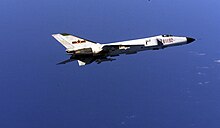PL-8 (missile)
The performance of Israeli Python-3 anti-air missile in the Lebanon conflict was observed by the Chinese military, People's Liberation Army Air Force (PLAAF) was reportedly impressed with this missile, and paid for licensed production as the PL-8 AAM in the 1980s, with the plan of producing the Python-3 with 100% local components approved by the PLAAF in 1982.
[3] The missile features wide off-boresight targeting sight with a dual-thrust solid rocket motor, giving it a speed of Mach 4.
The seeker of the original Python-3 AAM was able to be slaved to either the airborne fire control radars or DASH HMS.
The wingtip pylons of the newly released J-15 carrier-based fighter jet are also extended for this purpose, and has become a notable visual difference between the J-15 compared to the Su-33.
[5] The surface-to-air version is developed by China National Aero-Technology Import & Export Corporation (CATIC).
